Can Mesotherapy Help with Traction Alopecia?
Traction alopecia is a form of hair loss caused by repeated tension on the hair follicles. Unlike hormonal or autommune-related hair loss, it develops gradually from mechanical strain, often due to tight hairstyles. Left unaddressed, the affected follicles may stop producing hair altogether. But when identified early, traction alopecia can be reversed. This has led many people to ask whether treatments like mesotherapy can support recovery before permanent damage occurs.
In this article, we look at how traction alopecia develops, what makes it different from other types of hair loss, and whether mesotherapy has a meaningful role in helping the scalp recover.

What Is Traction Alopecia?
Traction alopecia occurs where there is continuous hair pulling and stress at the root. This weakens the follicle’s ability to anchor the hair and support normal growth. Over time, the tension disrupts the hair cycle, leading to increased shedding, thinning edges, and the development of bald patches in areas under the most strain, commonly the front, sides, or crown of the scalp.
Early traction alopecia is considered reversible. If the pulling force is removed, the follicle can return to normal function. However, if the tension continues for months or years, the follicle may miniaturise and eventually stop producing hair altogether. At that stage, regrowth becomes difficult without surgical intervention.
Why Does Hair Grow Back Thinner After Traction Alopecia?
When the follicle is subjected to repeated tension, its ability to produce a full-thickness terminal hair becomes compromised, even if regrowth is still possible. This thinning is typically due to three overlapping factors:
1. Mechanical miniaturisation
Chronic pulling weakens the connective tissue that anchors the hair follicle. Over time, this can mimic the effect of miniaturisation seen in androgenetic alopecia, producing shorter, finer, and lighter hairs. The follicle is still active but underperforms.
2. Disrupted hair cycling
Repeated pulling events can interfere with the natural cycling of the follicle, especially its re-entry into anagen. The hair remains in a prolonged telogen or kenogen state (a “resting” or “empty” phase), which leads to visibly sparse or inconsistent regrowth. Without proper stimulation, the follicle may not receive the signals it needs to regenerate the full-length shaft.
3. Nutrient vulnerability
When the follicle is recovering from injury, systemic issues like low iron or zinc become more significant. A healthy follicle may tolerate borderline deficiencies, but a damaged or recovering one cannot. If nutrients such as ferritin, vitamin D, or zinc are low, beomes less probable. The follicle lacks the resources to rebuild the full structural proteins (keratin) that build the hair fibre.
Each cycle of pulling and regrowth reduces follicular resilience. Eventually, the follicle may enter a “dormant” or fibrotic state, where hair no longer grows, and the skin appears smooth or shiny.
Can Mesotherapy Help?
Mesotherapy is not a cure for traction alopecia. However, it may support regrowth in cases where the hair follicles are still viable but have been weakened by ongoing tension. The treatment involves injecting small amounts of targeted ingredients into the scalp to improve circulation, stimulate hair production, and support tissue recovery.
In early-stage traction alopecia, where no fibrosis or dermal damage has occurred, mesotherapy may help accelerate recovery once the pulling force has been removed. It is especially useful in areas where regrowth is slow, or the follicle is struggling to re-enter the anagen (growth) phase.
In later stages of traction alopecia, where there is significant hair loss that has persisted for more than one year, exosome therapy may offer a more advanced regenerative option. Clinical studies have shown that exosomes can stimulate collagen production, restore vascular networks, and improve overall dermal architecture. By reactivating growth pathways and improving scalp tissue quality, exosome therapy has produced significant gains in hair density and thickness in patients with difficult-to-treat hair loss. It is increasingly used in clinics where the goal is to rebuild a depleted scalp environment and encourage fuller recovery in non-responsive areas.
The key requirement is that the cause of the tension must be eliminated first. No treatment, including mesotherapy, will be effective if the mechanical strain on the follicle continues.
Ingredients That May Be Beneficial
There is no universal mesotherapy formula for traction alopecia. However, certain ingredients are more relevant when the goal is to restore hair cycle activity and support follicular function.
-
Peptides such as copper tripeptide-1 may help support cell signalling and hair shaft strength.
-
Amino acids like arginine and lysine may be included to provide structural building blocks for keratin formation.
-
Growth factors are sometimes used to promote follicle activation and tissue support.
-
Hyaluronic acid (cross-linked) can improve scalp hydration and improve the delivery of other ingredients.
The goal in traction alopecia is to gently support the return of normal follicle function. Selecting a formulation that supports structure, circulation, and follicular energy may offer the best results.
What This Means for Recovery
Mesotherapy should only be used in traction alopecia after the styling practice causing tension has been stopped. Continuing with tight hairstyles during or after treatment may reduce the likelihood of regrowth or cause the hair loss to return. Switching to looser styles, rotating partings, or incorporating periods of rest can help reduce stress on vulnerable areas while allowing the scalp to recover.
It is also important to rule out other forms of hair loss that may appear similar, such as ophiasis-pattern alopecia areata, as the treatment approach would differ. In all cases, checking for underlying vitamin or mineral deficiencies (such as low ferritin, vitamin D, or zinc) is essential, as these can affect regrowth even after the mechanical tension has been resolved.
FAQs
Can mesotherapy regrow hair in traction alopecia?
Only if the follicles are still active. Mesotherapy can help support recovery in early stages but cannot restore hair in areas where the follicles are no longer viable. During later stages, exosome therapy is more appropriate.
How do I know if I still have active follicles?
Trichoscopy and scalp examination can help assess whether the follicle openings are still visible. If the scalp appears smooth and shiny in the affected area, this may suggest the follicles are no longer functioning.
What happens if I keep wearing the same hairstyle?
Mesotherapy is unlikely to be effective unless the source of tension is removed. Ongoing mechanical stress will continue to damage the follicle, even with treatment.
Is traction alopecia permanent?
It can be, if the remedial steps arent taken to resolve. Even in later stages hair can be recovered. Early intervention increases the chance of recovery.
References
-
Patel DP, Swink SM, Castelo-Soccio L. A review of the use of biotin for hair loss. Skin Appendage Disord. 2017;3(3):166–169.
-
Shome D, Vadera S, Kapoor R, Khare S, Sethi S. A multicentric study to evaluate the efficacy and safety of QR678 Neo hair growth formulation in the treatment of androgenetic alopecia. J Cosmet Dermatol. 2021;20(6):1556–1564.
-
Nassar A, Ismail SA, Badran HA. Efficacy of LC Hair Essence (zinc, arginine, peptides, and botanical extracts) versus botulinum toxin A in male androgenetic alopecia. J Cosmet Dermatol. 2022;21(10):4261–4268.




